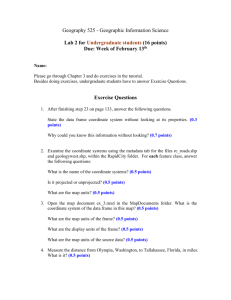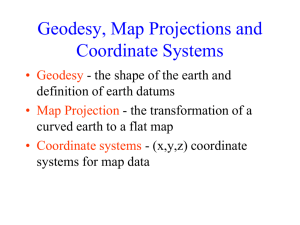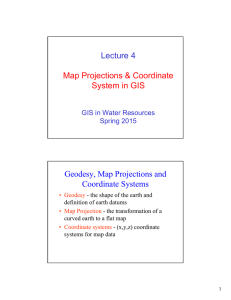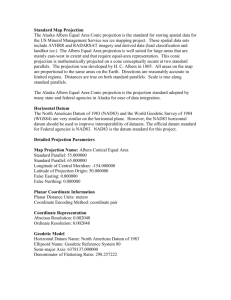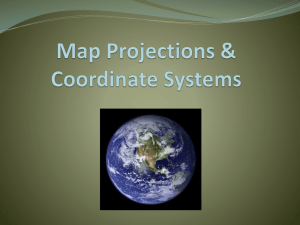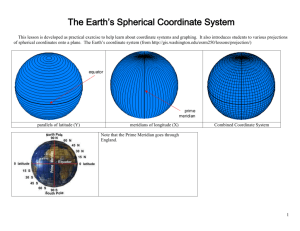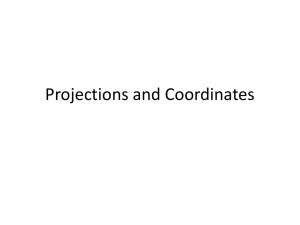MapProj
advertisement
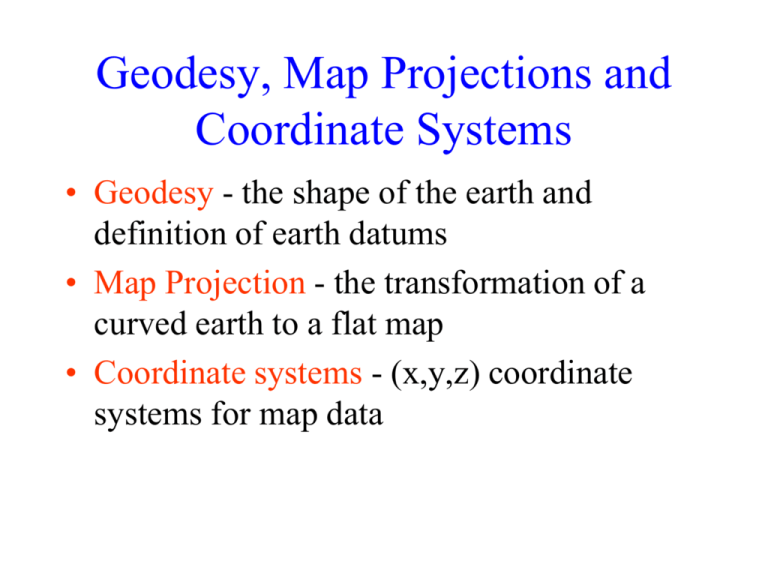
Geodesy, Map Projections and
Coordinate Systems
• Geodesy - the shape of the earth and
definition of earth datums
• Map Projection - the transformation of a
curved earth to a flat map
• Coordinate systems - (x,y,z) coordinate
systems for map data
Learning Objectives:
By the end of this class you should be able to:
•
•
•
•
•
describe the role of geodesy as a basis for earth datums
list the basic types of map projection
identify the properties of common map projections
properly use the terminology of common coordinate systems
use spatial references in ArcMap so that geographic data is
properly displayed
– determine the spatial reference system associated with a feature class or
data frame
– use ArcGIS to convert between coordinate systems
• calculate distances on a spherical earth and in a projected
coordinate system
Readings: Introduction
http://resources.arcgis.com/en/help/getting-started/articles/026n0000000s000000.htm
Readings: Further Detail
http://resources.arcgis.com/en/help/main/10.1/index.html#//003r00000001000000
Revolution in Earth Measurement
Some images and slides from Michael Dennis, National Geodetic
Survey and Lewis Lapine, South Carolina Geodetic Survey
Traditional Surveying
uses benchmarks as
reference points
Global Positioning uses
fixed GPS receivers as
reference points
(Continuously
Operating Reference
System, CORS)
Global Position Systems
(Press and hold)
Garmin GPSMAP 276C GPS Receiver
Trimble GeoXHTM
GPS Satellites
• 24 satellites
• 6 orbital planes
• 12 hour return interval for each satellite
Satellites are distributed among six offset orbital planes
How GPS works in five logical steps:
1.
2.
3.
4.
5.
The basis of GPS is triangulation from satellites
GPS receiver measures distance from satellite using
the travel time of radio signals
To measure travel time, GPS needs very accurate
timing
Along with distance, you need to know exactly
where the satellites are in space. Satellite location.
High orbits and careful monitoring are the secret
You must correct for any delays the signal
experiences as it travels through the atmosphere
Distance from satellite
• Radio waves = speed of light
– Receivers have nanosecond accuracy
(0.000000001 second)
• All satellites transmit same signal “string”
at same time
– Difference in time from satellite to time
received gives distance from satellite
Triangulation
Triangulation
GPS location of Mabel Lee Hall,
University of Nebraska, Lincoln
Differential GPS
• Differential GPS uses the time
sequence of observed errors at
fixed locations to adjust
simultaneous measurements at
mobile receivers
• A location measurement
accurate to 1 cm horizontally
and 2cm vertically is now
possible in 3 minutes with a
mobile receiver
• More accurate measurements
if the instrument is left in place
longer
This has to take Tectonic Motions into account
Tectonic Motions
From Sella et al.,
HORIZONTAL TECTONIC MOTIONS
Motion in cm/year
North American Plate
Pacific Plate
When is California not in North America …
…. when its on the Pacific Plate!
Types of Coordinate Systems
• (1) Global Cartesian coordinates (x,y,z) for
the whole earth
• (2) Geographic coordinates (f, l, z)
• (3) Projected coordinates (x, y, z) on a local
area of the earth’s surface
• The z-coordinate in (1) and (3) is defined
geometrically; in (2) the z-coordinate is
defined gravitationally
Global Cartesian Coordinates (x,y,z)
Z
Greenwich
Meridian
•
O
Y
X
Equator
Next 7 slides are from Dr Irmak
This leads to adjustments in locations of
the national network of survey
benchmarks
Survey Benchmark
{Latitude (f), Longitude (l), Elevation (z)}
Spatial Reference = Datum +
Projection +
Coordinate system
• For consistent analysis the spatial reference of
data sets should be the same.
• ArcGIS does projection on the fly so can display
data with different spatial references properly if
they are properly specified.
• ArcGIS terminology
– Define projection. Specify the projection for some
data without changing the data.
– Project. Change the data from one projection to
another.
Geographic Coordinates (f, l, z)
• Latitude (f) and Longitude (l) defined
using an ellipsoid, an ellipse rotated about
an axis
• Elevation (z) defined using geoid, a surface
of constant gravitational potential
• Earth datums define standard values of the
ellipsoid and geoid
Shape of the Earth
We think of the
earth as a sphere
It is actually a spheroid,
slightly larger in radius at
the equator than at the poles
Ellipse
An ellipse is defined by:
Focal length =
Distance (F1, P, F2) is
constant for all points
on ellipse
When = 0, ellipse = circle
Z
b
O
F1
For the earth:
Major axis, a = 6378 km
Minor axis, b = 6357 km
Flattening ratio, f = (a-b)/a
~ 1/300
P
a
X
F2
Ellipsoid or Spheroid
Rotate an ellipse around an axis
Z
b
a O a
X
Rotational axis
Y
Standard Ellipsoids
Ellipsoid
Major
Minor
Flattening
axis, a (m) axis, b (m) ratio, f
Clarke
(1866)
6,378,206 6,356,584 1/294.98
GRS80
6,378,137 6,356,752 1/298.57
Ref: Snyder, Map Projections, A working manual, USGS
Professional Paper 1395, p.12
Geodetic Datums
• World Geodetic System (WGS) – is a
global system for defining latitude and
longitude on earth independently of tectonic
movement (military)
• North American Datum (NAD) – is a
system defined for locating fixed objects on
the earth’s surface and includes tectonic
movement (civilian)
Horizontal Earth Datums
• An earth datum is defined by an ellipse and
an axis of rotation
• NAD27 (North American Datum of 1927)
uses the Clarke (1866) ellipsoid on a non
geocentric axis of rotation
• NAD83 (NAD,1983) uses the GRS80
ellipsoid on a geocentric axis of rotation
• WGS84 (World Geodetic System of 1984)
uses GRS80, almost the same as NAD83
Adjustments of the NAD83 Datum
Slightly different (f, l) for benchmark
Continuously Operating Reference Sy
Canadian Spatial Reference System
National Spatial Reference System
High Accuracy Reference Network
Representations of the Earth
Mean Sea Level is a surface of constant
gravitational potential called the Geoid
Sea surface
Ellipsoid
Earth surface
Geoid
THE GEOID AND TWO
ELLIPSOIDS
CLARKE 1866
(NAD27)
GRS80-WGS84
(NAD83)
Earth Mass
Center
Approximately
236 meters
GEOID
WGS 84 and NAD 83
International
Terrestrial
Reference Frame
(ITRF) includes
updates to WGS84 (~ 2 cm)
World Geodetic
System of 1984
(WGS 84) is
reference frame for
Global Positioning
Systems
North American
Datum of 1983
(NAD 83) (Civilian
Datum of US)
Earth Mass
Center
2.2 m (3-D)
dX,dY,dZ
GEOID
Definition of Latitude, f
m
O
q
f
S p
n
r
(1) Take a point S on the surface of the ellipsoid and define
there the tangent plane, mn
(2) Define the line pq through S and normal to the
tangent plane
(3) Angle pqr which this line makes with the equatorial
plane is the latitude f, of point S
Cutting Plane of a Meridian
P
Prime Meridian
Equator
Meridian
Definition of Longitude, l
l = the angle between a cutting plane on the prime meridian
and the cutting plane on the meridian through the point, P
-150°
180°E, W
150°
-120°
120°
90°W
(-90 °)
90°E
(+90 °)
P l
-60°
-30°
-60°
30°
0°E, W
Latitude and Longitude on a Sphere
Meridian of longitude
Z
Greenwich
meridian
l=0°
N
Parallel of latitude
P
•
W
•
•
X
O
l
Equator
R
=0°
•
E
l - Geographic longitude
- Geographic latitude
Y
R - Mean earth radius
O - Geocenter
Length on Meridians and Parallels
(Lat, Long) = (f, l)
Length on a Meridian:
AB = Re Df
(same for all latitudes)
R Dl
Re
Length on a Parallel:
CD = R Dl = Re Dl Cos f
(varies with latitude)
R
C
Df B
Re
A
D
Example: What is the length of a 1º increment along
on a meridian and on a parallel at 30N, 90W?
Radius of the earth = 6370 km.
Solution:
• A 1º angle has first to be converted to radians
p radians = 180 º, so 1º = p/180 = 3.1416/180 = 0.0175 radians
• For the meridian, DL = Re Df = 6370 * 0.0175 = 111 km
• For the parallel, DL = Re Dl Cos f
= 6370 * 0.0175 * Cos 30
= 96.5 km
• Parallels converge as poles are approached
Curved Earth Distance
(from A to B)
Shortest distance is along a “Great
Circle”
Z
A “Great Circle” is the intersection of
a sphere with a plane going through
its center.
B
A
1. Spherical coordinates converted
to Cartesian coordinates.
2. Vector dot product used to
calculate angle from latitude and
longitude
3. Great circle distance is R,
where R=6378.137 km2
•
Y
X
Dist = R cos 1[sin f A sin fB cos f A cos fB cos(lA lB )]
Ref: Meyer, T.H. (2010), Introduction to Geometrical and Physical Geodesy, ESRI Press, Redlands, p. 108
Three systems for measuring
elevation
Orthometric heights
(land surveys, geoid)
Ellipsoidal heights
(lidar, GPS)
Tidal heights
(Sea water level)
Conversion among these height systems has some uncertainty
Trends in Tide Levels
(coastal flood risk is changing)
Charleston, SC
+ 1.08 ft/century
1900
2000
Galveston, TX
+ 2.13 ft/century
- 4.16 ft/century
1900
Juneau, AK
2000
1900
2000
Geoid and Ellipsoid
Earth surface
Ocean
Geoid
Gravity Anomaly
Gravity anomaly is the elevation difference between
a standard shape of the earth (ellipsoid) and a surface
of constant gravitational potential (geoid)
Definition of Elevation
Elevation Z
P
•
z = zp
z = 0 Land Surface
Mean Sea level = Geoid
Elevation is measured from the Geoid
http://www.csr.utexas.edu/ocean/mss.html
Gravity Recovery and Climate Experiment (GRACE)
Force of gravity responds to changes in water volume
Water is really heavy! Gravity is varying in time and space.
Gravity Anomaly of Texas, 2002 – 2012
Normal
In 2011, we lost 100 Km3 of water or 3 Lake Mead’s
GRACE and Texas Reservoir Water Storage
Surface water reservoir storage is closely correlated with the GRACE data
Grace Satellites
Normal
In 2011 we lost 100 Km3 of water overall
Surface Water
Reservoirs
Normal
In 2011 we lost 9 Km3 of water from reservoirs
Vertical Earth Datums
• A vertical datum defines elevation, z
• NGVD29 (National Geodetic Vertical
Datum of 1929)
• NAVD88 (North American Vertical Datum
of 1988)
• takes into account a map of gravity
anomalies between the ellipsoid and the
geoid
Converting Vertical Datums
• Corps program Corpscon (not in ArcInfo)
– http://crunch.tec.army.mil/software/corpscon/corpscon.html
Point file attributed with the
elevation difference between
NGVD 29 and NAVD 88
NGVD 29 terrain + adjustment
= NAVD 88 terrain elevation
Importance of geodetic datums
NAVD88 – NGVD29 (cm)
NGVD29 higher
in East
More than 1 meter difference
NAVD88 higher
in West
Orthometric datum height shifts are significant relative to BFE
accuracy, so standardization on NAVD88 is justified
Geodesy and Map Projections
• Geodesy - the shape of the earth and
definition of earth datums
• Map Projection - the transformation of a
curved earth to a flat map
• Coordinate systems - (x,y) coordinate
systems for map data
Earth to Globe to Map
Map Scale:
Map Projection:
Scale Factor
Representative Fraction
= Globe distance
Earth distance
(e.g. 1:24,000)
=
Map distance
Globe distance
(e.g. 0.9996)
Geographic and Projected Coordinates
(f, l)
Map Projection
(x, y)
Types of Projections
• Conic (Albers Equal Area, Lambert
Conformal Conic) - good for East-West
land areas
• Cylindrical (Transverse Mercator) - good
for North-South land areas
• Azimuthal (Lambert Azimuthal Equal Area)
- good for global views
Conic Projections
(Albers, Lambert)
Cylindrical Projections
(Mercator)
Transverse
Oblique
Azimuthal
(Lambert)
Albers Equal Area Conic Projection
Lambert Conformal Conic Projection
Universal Transverse Mercator Projection
Lambert Azimuthal Equal Area Projection
Web Mercator Projection
(used for ESRI Basemaps)
Web Mercator is one of the
most popular coordinate
systems used in web
applications because it fits the
entire globe into a square area
that can be covered by 256 by
256 pixel tiles.
The spatial reference for the
ArcGIS Online / Google
Maps / Bing Maps tiling
scheme is WGS 1984 Web
Mercator (Auxiliary
Sphere).
Web Mercator
Parameters
(20037, 19971 km)
= earth rad * Π
Standard Parallel
(0,0)
6357 km
6378 km
Earth radius
Central Meridian
Projections Preserve Some
Earth Properties
• Area - correct earth surface area (Albers
Equal Area) important for mass balances
• Shape - local angles are shown correctly
(Lambert Conformal Conic)
• Direction - all directions are shown correctly
relative to the center (Lambert Azimuthal
Equal Area)
• Distance - preserved along particular lines
• Some projections preserve two properties
Projection and Datum
Two datasets can differ in both the
projection and the datum, so it is
important to know both for every
dataset.
Geodesy and Map Projections
• Geodesy - the shape of the earth and
definition of earth datums
• Map Projection - the transformation of a
curved earth to a flat map
• Coordinate systems - (x,y) coordinate
systems for map data
Coordinate Systems
• Universal Transverse Mercator (UTM) - a
global system developed by the US Military
Services
• State Plane Coordinate System - civilian
system for defining legal boundaries
• Texas Centric Mapping System - a
statewide coordinate system for Texas
Coordinate System
A planar coordinate system is defined by a pair
of orthogonal (x,y) axes drawn through an origin
Y
X
Origin
(xo,yo)
(fo,lo)
Universal Transverse
Mercator
• Uses the Transverse Mercator projection
• Each zone has a Central Meridian (lo),
zones are 6° wide, and go from pole to pole
• 60 zones cover the earth from East to West
• Reference Latitude (fo), is the equator
• (Xshift, Yshift) = (xo,yo) = (500000, 0) in
the Northern Hemisphere, units are meters
UTM Zone 14
-99°
-102°
-96°
6°
Origin
-120°
-90 °
Equator
-60 °
State Plane Coordinate System
• Defined for each State in the United States
• East-West States (e.g. Texas) use Lambert
Conformal Conic, North-South States (e.g.
California) use Transverse Mercator
• Texas has five zones (North, North Central,
Central, South Central, South) to give
accurate representation
• Greatest accuracy for local measurements
ArcGIS Spatial Reference Frames
• Defined for a feature
dataset in ArcCatalog
• XY Coordinate System
– Projected
– Geographic
• Z Coordinate system
• Domain, resolution and
tolerance
Horizontal Coordinate Systems
• Geographic
coordinates (decimal
degrees)
• Projected coordinates
(length units, ft or
meters)
Vertical Coordinate Systems
• None for 2D
data
• Necessary for
3D data
ArcGIS .prj files
Summary Concepts
• The spatial reference of a dataset comprises
datum, projection and coordinate system.
• For consistent analysis the spatial reference
of data sets should be the same.
• ArcGIS does projection on the fly so can
display data with different spatial references
properly if they are properly specified.
• ArcGIS terminology
– Define projection. Specify the projection for
some data without changing the data.
– Project. Change the data from one projection
to another.
Summary Concepts (Cont.)
• Two basic locational systems: geometric or
Cartesian (x, y, z) and geographic or
gravitational (f, l, z)
• Mean sea level surface or geoid is
approximated by an ellipsoid to define an
earth datum which gives (f, l) and distance
above geoid gives (z)
Summary Concepts (Cont.)
• To prepare a map, the earth is first reduced
to a globe and then projected onto a flat
surface
• Three basic types of map projections: conic,
cylindrical and azimuthal
• A particular projection is defined by a
datum, a projection type and a set of
projection parameters
Summary Concepts (Cont.)
• Standard coordinate systems use particular
projections over zones of the earth’s surface
• Types of standard coordinate systems:
UTM, State Plane
• Web Mercator coordinate system (WGS84
datum) is standard for ArcGIS basemaps
